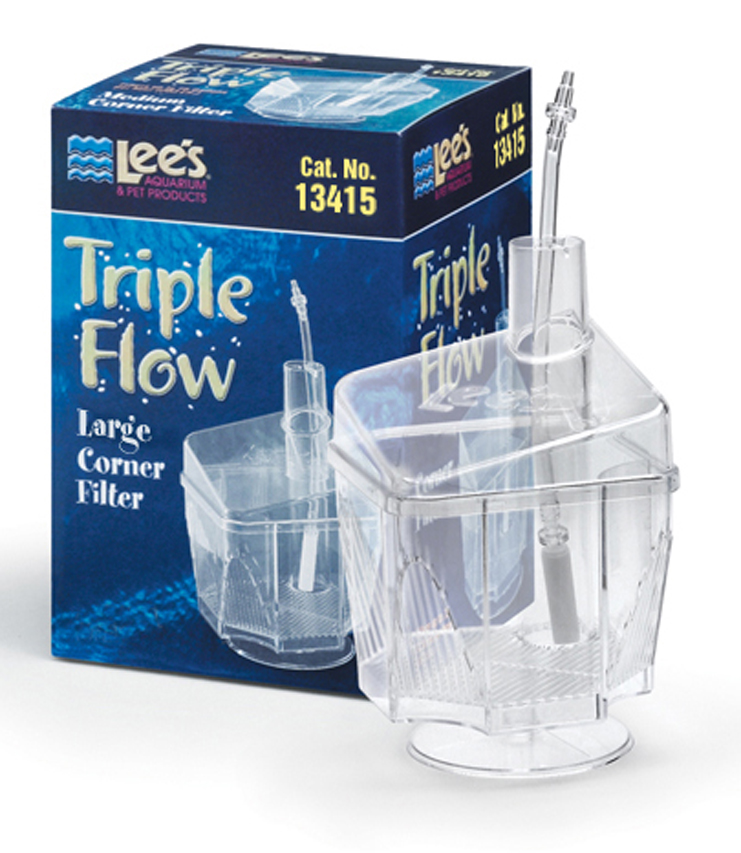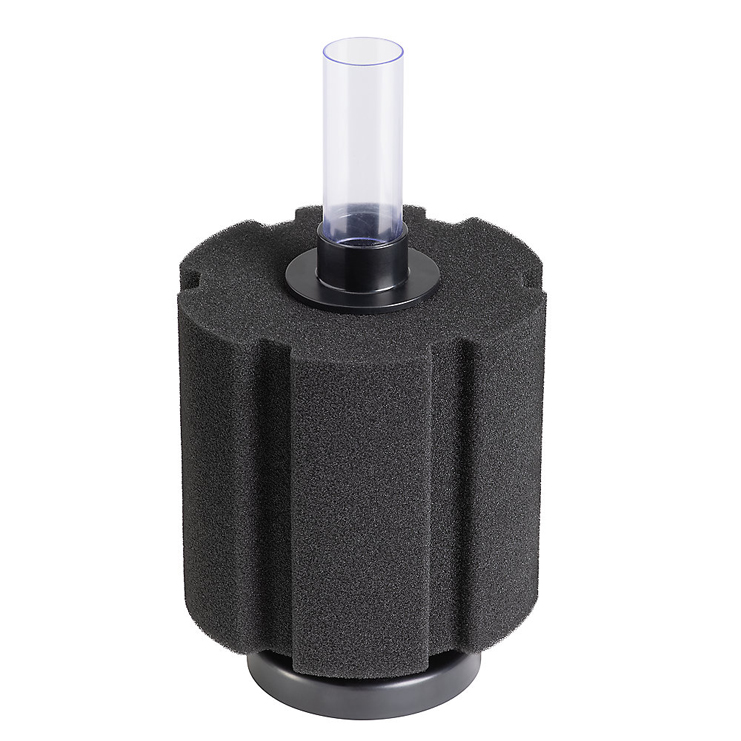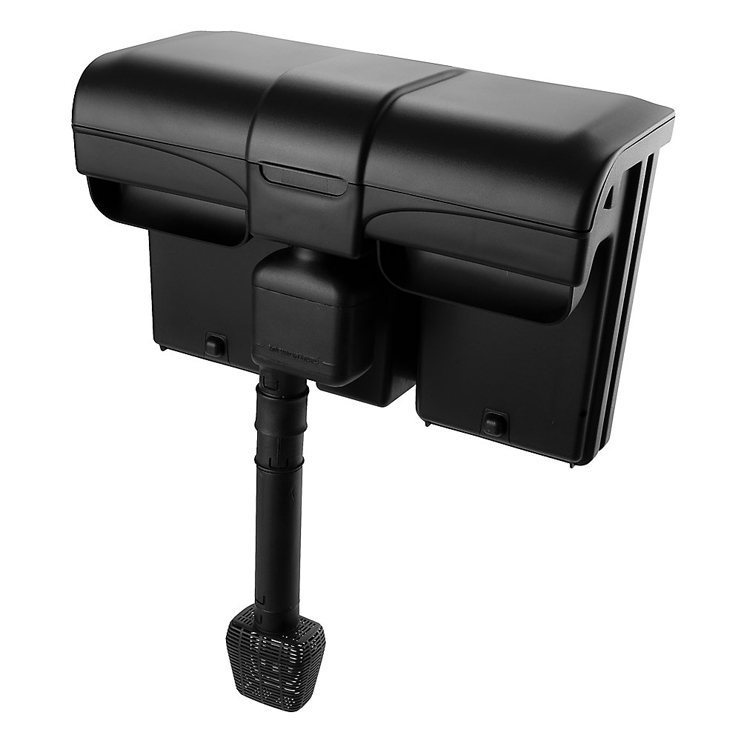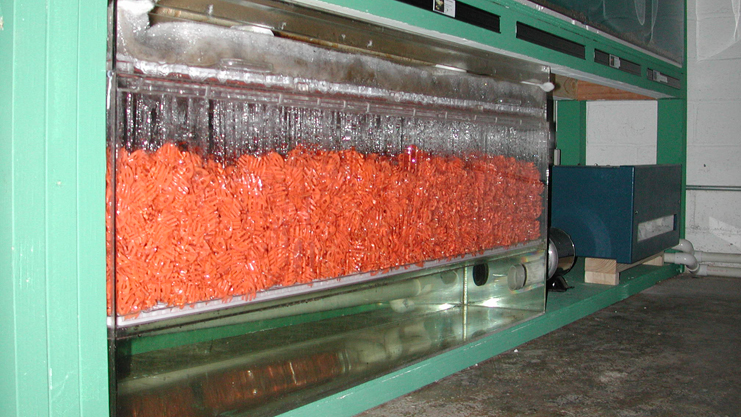Filtration
When you think of filtration the first thing that comes to mind is some kind of device that strains fine particles out of the water to make the water clear. Many types of filtration incorporate biological filtration (bacterial breaking down of ammonia and nitrite into nitrate), chemical, and particulate. While a device is commonly used in aquariums to filter the water, it is not required to have a healthy ecosystem. The only filtration required to maintain a healthy ecosystem is biological.
The fish we keep in our aquariums come from many different biotopes. Some fish like stagnant pools of water, while others are found in fast flowing rivers. When deciding which fish to keep, you should do the research to find out where the fish are found in the wild, and try and duplicate similar conditions in the aquarium.
Some current, in most cases, should be provided in the aquarium, even for fish that like stagnant water, as aquarium lights will transfer heat. If the aquarium is totally stagnant, the top few inches can easily become 10º F (6º C) warmer than bottom few inches. In nature, when the wind blows across even small pools of water current is created.
For most fish that we keep in aquariums, a turnover rate of 4 times an hour is adequate, but in some cases more or less would be preferred. In aquariums with river fish that like current, a turnover rate of 10 times an hour or more may be best. Many anabantoids would prefer a calm surface in which to build a bubble nest.
The bacteria that transform ammonia/ammonium/nitrite into nitrate colonize surface area in an aquarium ecosystem that receives constant contact with the oxygen rich water column. All surface in a filtration system is also colonized by beneficial bacteria. Many aquarium filter manufacturers incorporate some form of dense material in the filter design that allows it to be heavily colonized by nitrifying bacteria.
Filtration systems that incorporate biological filtration, can have an adverse affect on the aquarium after an extended power outage, or a thorough cleaning. Since materials used in filters for biological filtration are in high flow areas they become heavily colonized by nitrifying bacteria in densities that are in higher concentrations than what is in the aquarium.
When power is lost for an extended period, the bacteria on these materials can use up the oxygen in the surrounding water quickly and then start to die. When the filter is restarted, a significant portion of the ecosystems beneficial bacteria have been lost, thus resulting in a significant ammonia and/or nitrite spike a few days later that can cause fish mortality.
When cleaning biological media, significant amounts of beneficial bacteria can be lost. Many hobbyist suggest using aquarium water to clean biological media, but even with aquarium water beneficial bacteria can be lost. For most aquarium systems, it is best if the biological filtration occurs in the aquarium and not the filter.
In fish hatcheries it is common to see trickle filtration systems with towers filled with bio-media. The bio-media is used to support high fish stocking densities in fish hatcheries, where tanks are kept bare for easy maintenance and have very little surface area.
The most common forms of chemical filtration is the use of activated carbon and zeolite. Chemical filtration is not necessary for maintaining a healthy ecosystem. Chemical filtration has its purpose in the hobby, but it is not recommended for regular filtration. Chemical filtration does not remove nitrate, and will not extend the time between required water changes.
Many filtration systems include some activated carbon. Activated carbon is effective at removing most medications and tannins that make the water yellow or tea color. It can also remove beneficial trace elements, that are used by plants.
Zeolite is a white mineral marketed for freshwater aquariums to pull ammonia out of solution. Zeolite does not work in saltwater. Zeolite can be recharged by soaking it overnight in saltwater. The use of zeolite is not necessary for maintaining a healthy aquarium. Once zeolite has been added to the filtration system it will eventually become colonized by nitrifying bacteria and become biological filtration media.
Another form a chemical filtration that is sometimes used to control algae growth are phosphate removers. Phosphate removers have proven to be effective in cases where high phosphate levels fuel undesirable algae growth. Keep in mind when using these products if you are trying to keep live plants, plants need a trace amount of phosphate for proper growth. To little phosphate in the system can affect plant growth.
Particulate filtration is the collection of waterborne organic matter on or in some type of media. Polyester fiber, filter fiber, sponge, and gravel are common types of media used to collect particulates.
The best designs for collecting particulate are thin to limit the amount of surface area for bacteria to live on. When particulate filters are cleaned, much of the beneficial bacteria that have colonized the surface of the media are lost to the aquarium ecosystem. For this reason it is best if the particulate filter has a limited amount of surface area to minimize the impact on the beneficial bacteria population when they are cleaned or replaced.

Under gravel (UG) filter uses a raised filter plate that sits on the bottom of the aquarium. The plate typically has slots to allow water to pass through. Uplift tubes in the corner of the plate are either air driven or have a powerhead on top to help pull water through the plate. Gravel is used on top of the plate to act as a medium to provide a surface for beneficial bacteria to live on and provide for particulate filtration.
UG filter systems were common in the 1970’s and 1980’s, but today they are rarely used. Under gravel filtration is an adequate filtration system as long as you don't plan on keeping live plants or fish that like to dig. Many UG filters come with activated carbon or zeolite caps for the uplift tubes. I recommend that you do not use these caps, because they restrict the water flow through the gravel bed.
If you want to use chemical filtration with a UG filtration system, the best way, is to add the media to a nylon filter bag, rinse it out under tap water, flatten it out on the filter plate near the uplift tube, then cover it up with gravel.
You will need to use a gravel vacuum to pull the detritus out of the gravel bed that will build up over time. The gravel should be vacuumed at least all of the way down to the filter plate once every two weeks.
UG filters usually work quite well for the first 4 to 6 months, but they can become problematic in aquariums that have been setup for a long time. Detritus will build up under the filter plate and cannot be removed with vacuuming. Usually, you will have to take down the entire aquarium to clean out this detritus. Taking down an entire aquarium is not something I recommend if you plan on restocking with the same fish as you may end up going through establishing a nitrogen cycle again.
Some hobbyist have used UG filters in a reverse flow configuration. With a reverse flow, the water is pre-filtered and forced under the plate, allowing water to come up through the substrate. This configuration will still build up detritus over time, just not as fast as the typical configuration.
Large cichlids that like to dig and move substrate around are a poor choice for aquariums that have a UG filtration system. When the gravel is not even across the bottom, water will follow the path a least resistance. This can cause dead spots in the UG filtration system and affect the efficiency of the filtration.
Because of the water quality issues that can develop with UG filters, they are my last choice when choosing a filtration system for an aquarium.

Box filters are air driven filters that are normally placed in a corner. They can contain chemical filtration media, biological media, and polyester fiber for particulate filtration. Some hobbyist use box filters in breeding tanks, as their gentle filtration will normally be fry safe. Box filters are easy to clean, and multiple filters can be powered by a single air pump.

The most common sponge filters have an uplift tube that has a sponge attached to the end that collects floating detritus. They provide a lot of surface area for beneficial bacteria to colonize. Sponge filters are used most commonly in small aquariums, and bare bottom fish breeding tanks. Sponge filters come in many sizes and shapes. Sponge filters are most commonly air driven, but some aquarium product manufacturers do make power driven sponge filters.
Sponge filters have a limited particulate filtering capacity, but have a lot of surface area for biological filtration. At least every two weeks a sponge filter should be removed from the aquarium and rinsed out with fresh water from the tap (about the same temperature as the tank). A quick rinse with tap water will not likely kill beneficial bacteria, but if you want to be cautious you can use aquarium water.
Cleaning a sponge filter will cause the loss of beneficial bacteria, whether you use tap or aquarium water. Nitrite poisoning can occur a few days after sponge has been cleaned when they are used in an aquarium with limited surface outside the sponge, like bare bottom breeding/rearing tanks. You should test your aquarium water two to three days after a cleaning to make sure ammonia and nitrite stay at 0 ppm.
Because sponge filters have limited particulate filtration capability, aquariums that use them often have detritus collection spots on the bottom that will require removal with a syphon hose or gravel vacuum.

Canister filters are usually placed on the floor, or in the aquarium cabinet. They have two tubes coming out of them, one to draw water out of the aquarium and the other to return clean water back to the aquarium. Canister filters act as a particulate, chemical, and biological filter.
Canister filters have some advantages and disadvantages. Canister filters are often difficult to clean and often do not seal well after cleaning, leading to a leaks.
One advantage of a canister filter is that you can add an ultraviolet sterilizer in line with the return line to the aquarium. Some canister filters use diatomaceous earth (diatom powder) to polish the water. Diatom filters are used only temporarily to remove very fine floating detritus. These filters are usually only run on an aquarium for a couple of hours, before they are removed and cleaned.
If you have problems with a canister filter sealing, you can use petroleum jelly on the “O” ring to get a good seal. This is all it takes most of the time to get a canister filter to seal properly. If petroleum jelly doesn’t work it is probably time to buy a new replacement “O” ring.
Canister filters should be cleaned at least every two weeks. Because canister filters are often hidden away in a cabinet, aquarist often forget to clean them as often as they should (out of sight, out of mind). Canister filters are also more difficult to clean than many other styles of aquarium filters, which also leads to them not being cleaned as often as they should.

Hang on the tank power filters come in many shapes and sizes. The primary purpose of hang on the tank power filters is to filter out fine particles of detritus. Most of the hang on the tank power filters provide an area to place carbon or other chemical filtration media, or have carbon enclosed in a filter cartridge. Many hang on the tank power filters have incorporated some type of biological filtration media in the design of the filter. Most of these filters are self priming provided that you first fill the filter up with water. Most hang on the tank filters are easy to clean, and some allow the use of different types of media.
The ease of cleaning makes hang on the tank power filters a very popular choice for aquariums of 100 gallons (380 l) or less.

Trickle, sump, and refugium are common types of filtration systems that use a container that is typically made of acrylic, or a glass tank. These types of filters are normally housed in a cabinet underneath the aquarium. They are common on large marine aquariums, but are also very good filters for freshwater tanks.
Sump style filters are powered by either an internal sump pump or external pump. Internal sump pumps tend to be quieter, but they can transfer heat to the aquarium water. External pumps are often more energy efficient, some are very quiet. With an external pump, a cabinet needs to be ventilated or heat can build up and transfer to the aquarium water.
Some things you should look for when selecting a sump style filter:
If your aquarium does not have a built in skimmer (normally in a back corner) you will need a hang on the back pre-filter skimmer. These filters have a cup with slats cut into the top of it that sets inside the aquarium. The skimmer cup helps prevent fish from being filtered out of the aquarium. When the pre-filter is working correctly the water going into the skimmer cup will fall into the cup causing the surface of the aquarium and any proteins collected at the surface to be skimmed off. The surface of the water in the skimmer cup should be a minimum of 3/4 to 1 inch (2 to 2.5 cm) below the aquarium water surface for optimal skimming.
All sump filtration systems operate very similarly. When setting up the system you must not overfill the sump, otherwise, if the power cuts out, you will end up with water over flowing onto the floor.
You can figure out the maximum operating water level height of a sump by cutting the power to the pump, and allowing the water from the main display to drain for about 5 minutes. Fill the sump with tap water to a point just below the point where water would overflow. Start the pump back up and allow the filtration system to run for about 5 minutes. Mark the water level on the sump with tape or a permanent marker. The mark on the sump will be the absolute maximum operating water level. Minimum operating water level in the sump will be the point where the pump starts drawing air.
Sump style filtration systems do evaporate a lot of water and will need to be topped off frequently.
Trickle (a.k.a. Wet/Dry) filters incorporate particulate, biological, and sometimes chemical filtration in their design. The water is first passed through a pre-filter (particulate filter) either in a corner of the aquarium, hang on the back of the aquarium, or top of the filter. The basic principal behind the trickle filter is to pass a trickle of filtered water over a media (plastic balls, plastic cubes, double layer spiral (DLS), or PVC) that serves as a surface area for beneficial bacteria.

Trickle filters oxygenate the water as it cascades through the biological media. Most trickle filters use a drip tray to distribute water over the bio-media. In most models you can add a heater to the sump, removing it from the aquarium.
Trickle filters come in several shapes and sizes. Some trickle filters are even built into the back of acrylic aquariums. A trickle filter is typically hidden inside the aquarium cabinet. The installation process and access to the filter must be considered when selecting a cabinet and filter.
Trickle filters only have about 4 inches (10 cm) of water in the bottom of the filter sump allowing the biological media to be exposed to air. The advantage of removing the biological surface area out of the aquarium and exposing it to air is enormous, as it provides beneficial bacteria with a highly oxygenated environment. Bacteria in trickle filters can reach high population densities on the media. Beneficial bacteria thrive in this environment and break down ammonia and nitrite much quicker than the bacteria in the aquarium.
Because trickle filters have excellent biological filtration capability, they are often used on systems with high density stocking levels, like rearing systems. Trickle filters are also often used as a central filtration system for multiple aquariums.
Adding an airline to the bio-media chamber to pump in fresh air from an air pump can help get fresh oxygen to the bacteria. Most trickle filter builders neglect to add this feature to their filters, but you can modify the filter quite easily by drilling a hole in the side (if made of acrylic) of the bio-media chamber, and cement a hard plastic air tube going directly into the middle of the bio-media. Without this air being pumped into the bio-media chamber, gas exchange can limit the potential efficiency of the filter.
Sump filters are the evolution of the trickle filter. Sump filters typically use a micron bag to filter the particulate from the aquarium water. Sump filters do not use bio-media, as the intent in this design is to let biological filtration to take place on the surface area within the aquarium. Water is oxygenated while it passes through the bag filter. Like the trickle filter, sump filters are powered by either an internal sump pump or external pump.

Refugium filters are common in the marine hobby, but are often overlooked by freshwater aquarists. A refugium, by aquarium hobby definition, is a container that a refuge for ecosystem organisms. A refugium is typically an aquarium placed underneath the main display tank that has water cycle through it from the main display. Most often it houses fast growing plants that help remove nitrate from the aquarium system. Refugiums primary purpose is to remove nitrate, but it can also be used to harbor small shrimp or fish that would otherwise be eaten by fish in the main display. Refugiums are usually brightly lit with CFL, High Output T5, or metal halide lights to stimulate vigorous plant growth, and uptake of nutrients.
A refugium filter should be considered if you plan on keeping fish that are not compatible with aquatic plants. Large Central and South American cichlids like, oscars (Astronotus ocellatus), peacock bass (Cichla ocellaris), red devils (Amphilophus citrinellum), and others can all benefit from the nitrate reduction capabilities of a refugium.
Hydroponics filtration is a very effective way of removing nitrate from the aquarium system. Many types of plants can be used with a hydroponics filtration system, including edible plants. Hydroponics systems are more efficient at removing nitrate from the water than plants submerged in the aquarium because of the higher concentration of carbon dioxide in the air. A hydroponics filter can be placed either above or below a main display.
Hydroponics systems should also be considered for fish hatcheries to optimize water quality and fish growth rates. Large aquariums with fish that would normally eat or damage aquatic plants are prime candidates for a hydroponics filtration system. A hydroponics system can also be used as container for a breeding colony of freshwater shrimp or small fish.